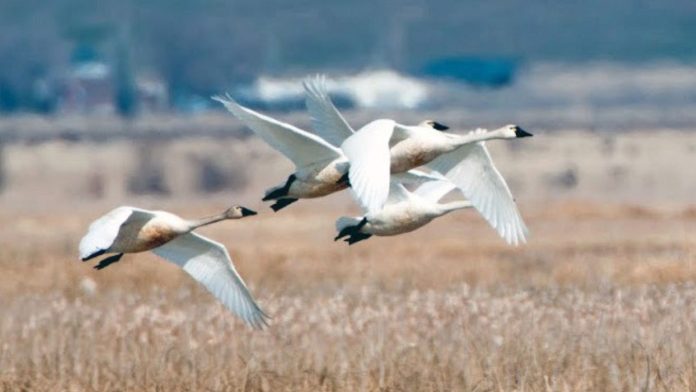SALT LAKE CITY, Utah, Feb. 22, 2024 (Gephardt Daily) — As spring approaches, so are Utah’s regular swan visitors by the thousands.
“Wild swans are fun to watch, whether they’re on the water or in the air,” the Utah Division of Wildlife Resources said on social media. “Thousands of swans will wing their way through Utah in March, making it the perfect time to see them!”
“Swans are amazing birds to see in flight,” DWR Northern Region Outreach Manager Mark Hadley said. “You’ll have no problem spotting them — they’re huge and almost pure white in color.”
Once the swans start their spring migration, two spots in northern Utah get the nod for viewing from the DWR: Compton’s Knoll at the Salt Creek Waterfowl Management Area and the auto tour route at the Bear River Migratory Bird Refuge.
The bird refuge just west of Brigham City historically has recorded swan counts reaching as high as 20,000.
Two types of swans can be seen migrating through Utah during different times of the year, the DWR said. Both tundra swans and trumpeter swans stop in Utah’s wetlands for some much-needed rest and refueling during their migration north in the spring.
Trumpeter swans are significantly larger than tundra swans. Trumpeter swans do not have a yellow-colored area near their eyes, and they also make a distinctive trumpet-like sound, hence their name.
The birds’ spring migration takes the swans from wintering grounds in California to nesting sites in Canada and Alaska.
Salt Creek Waterfowl Management Area
The Compton’s Knoll viewing area — a small hill on the southeast side of the Salt Creek Waterfowl Management Area — is a perfect place to view swans and other birds, according to DWR. The hill places you above the marsh, providing viewing opportunities for those who have binoculars or spotting scopes. Two bird viewing blinds are also located at the bottom of the hill.
The Salt Creek WMA is about 12 miles northwest of Corinne. Except for the Compton’s Knoll viewing area, the rest of the WMA is closed for different parts of the year.
Visitors are asked to remain behind closed gates and only view the swans from Compton’s Knoll or the two bird viewing blinds at the bottom of the hill.
Bear River Migratory Bird Refuge
Managed by the U.S. Fish and Wildlife Service, the refuge — and its Bear River Migratory Bird Refuge Auto Tour Route — is another great place to see migrating swans in Utah, according to DWR. It is located about 12 miles west of Brigham City.
To reach the auto tour route, exit I-15 at exit 363, and travel west on West Forest Street until you come to a large parking area with an observation tower. Stop at the tower to look for swans in the marsh to the north.
Visitors can then drive along the 12-mile auto tour route through the heart of the refuge. You could see thousands of swans in the wetlands along the driving route.
Farmington Bay Wildlife Management Area
You can also sometimes see migrating swans at the DWR’s George S. and Dolores Doré Eccles Wildlife Education Center and Hasenyager Preserve. The DWR’s Eccles Wildlife Education Center is part of the Farmington Bay Waterfowl Management Area.
The WMA is closed to vehicle traffic from March 1 until September, but the education center is open 11:30 a.m. to 3:30 p.m. Tuesday-Saturday.







